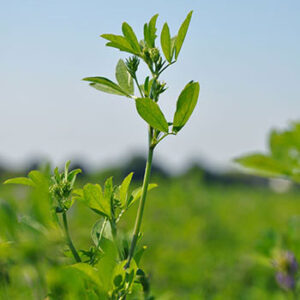
From Field to Feed
Feed is crucial to the health, welfare and performance of our horses and we know how important it is to you to be doing the best for your horse. That doesn’t mean you have to be feeding every supplement or spending a fortune on lots of different bags of feed, in fact, very often the simpler the diet the better it is for the horse. What you do want to be sure of is that the feed you use is as natural as possible and will be sympathetic to your horse’s digestive system.
At Dengie we grow as many of the ingredients we use as possible ourselves and source as locally as we can to keep our “feed miles” down and support UK farmers. We are very proud to say that we can trace the fibre ingredients in every bag we make right back to the field they were grown in to create natural and safe feeds you can trust. The 6,000 acres of alfalfa we grow are within a twenty mile radius of our production sites meaning we can bring the crop in from the fields as efficiently as possible maximising the nutrition in the feed and keeping our carbon footprint down. Back in 2014 we changed from using soya oil grown in Brazil to rapeseed oil grown in the UK and in 2016 we introduced a product that included cold-pressed rape seed oil. We feel it is important to provide a range of products with different coatings so that each horse owner can choose the one that best suits their horse’s needs.
The Dengie philosophy is to create the best and healthiest horse feeds we can and support for research projects into equine nutrition plays an important part in the company’s ongoing commitment to improve horse health. Dengie employs a team of highly qualified nutritionists who are actively involved in research projects with respected institutions around the world. This includes working with agronomists to develop the alfalfa so it is even more nutritious for your horse – we are in the enviable position of being able to influence our feed right from the seed!
The life and times of Dengie alfalfa
 Alfalfa is a perennial plant and stays in the ground for between three and four years providing winter ground cover for birds and insects. A legume, it is able to fix nitrogen from the atmosphere and return it to the soil. Fewer artificial fertilisers are required which has environmental benefits.
Alfalfa is a perennial plant and stays in the ground for between three and four years providing winter ground cover for birds and insects. A legume, it is able to fix nitrogen from the atmosphere and return it to the soil. Fewer artificial fertilisers are required which has environmental benefits.
In year 1 the alfalfa is harvested twice to enable it to become established. In years 2 to 4 it is cut three times between April and October in six to seven week cycles. The long harvest period means the weather conditions can vary quite considerably producing a range of material with varying amounts of leaf and stalk.
Dengie pioneered the use of high temperature drying to conserve forage for horses in the UK. This allows crops to be harvested for a much longer season and when the plants are immature so they are more digestible and higher in energy and nutrients. High temperature drying produces feeds with very low mould counts compared to sun dried forages such as hay and straw.
Why does the appearance of the finished product vary?
As alfalfa is a natural material the end product can vary in appearance but this is no different to the variations in colour, size and shape of the fruit and vegetables that we eat. Colour variation in the finished product is something that most people will notice at some stage and whilst some bags can appear bright green others may appear brown. The main factor influencing the colour of alfalfa is the weather with wet and warm conditions producing green, leafy plants while dry and hot weather tends to result in browner material. Although the alfalfa is mixed to try to create a consistent finished product, this can be difficult in years when extreme weather is experienced as most of the crop will be the same.
The alfalfa can also vary in texture which relates to the proportion of leaf and stem it contains. The stems of the alfalfa plant are very fibrous whereas the leaf is very nutritious. The weather determines how quickly the plant is growing and if the conditions are right, it can mature very quickly making it more fibrous. In contrast, leafy alfalfa can look very “bitty” in the bag – as the leaf is the most nutritious part it is vital that it is included in the feed and the addition of coatings should help to ensure it is evenly distributed through the bag.

